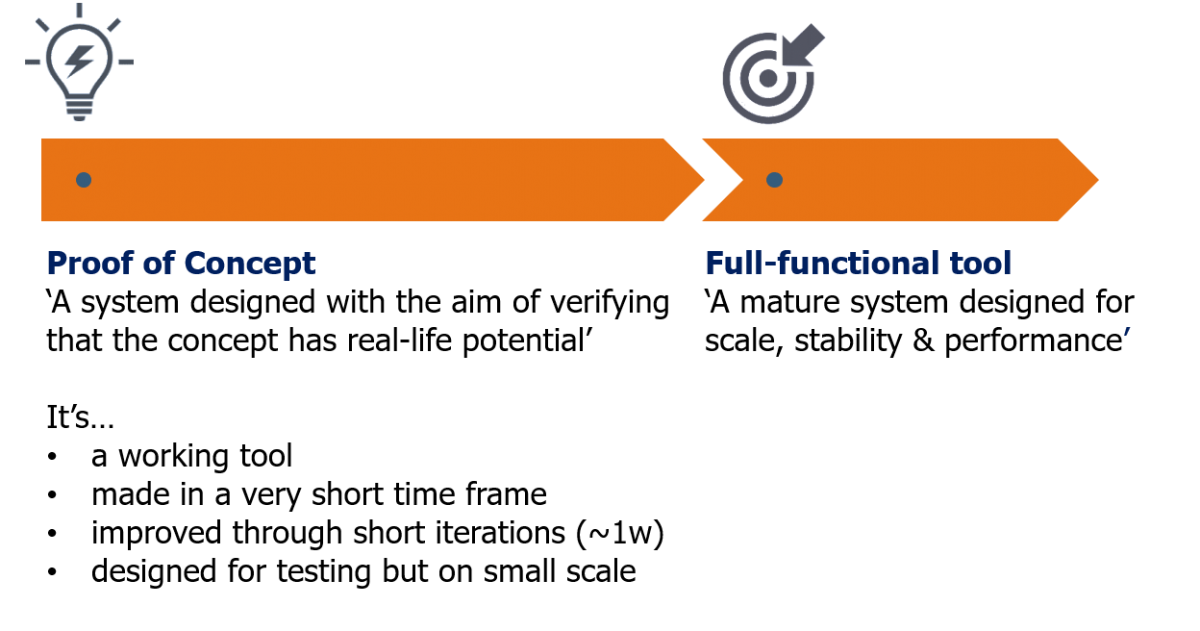We are convinced Analytics can be accessible for companies of all sizes, doesn't require a big investment, and will bring added value.
Why a Proof of Concept
 We believe that it's important to go step-by-step and to start with a simple use-case showing tangible results (i.e., a proof of concept). This allows the organization to learn and grasp the value that Data Science can bring. As the organization gains confidence, it can proceed in choosing technology, maturing in smartness, and running more use cases. Along this full learning and implementation cycle, element61 can help.
We believe that it's important to go step-by-step and to start with a simple use-case showing tangible results (i.e., a proof of concept). This allows the organization to learn and grasp the value that Data Science can bring. As the organization gains confidence, it can proceed in choosing technology, maturing in smartness, and running more use cases. Along this full learning and implementation cycle, element61 can help.
What's a Proof of Concept
A Proof of Concept is an opportunity for an organization to test and learn. The objective of the Advanced Analytics Proof of Concept is to provide the customer with a working application as well as to create a common internal understanding of key concepts and technologies. The application (or use-case) is chosen together with the customer and should be in line with strategic pain points and opportunities (e.g., stock inventory forecast to tackle the increasing cost of depreciations, cross-sell tool to support marketing team dealing with a rising churn rate, demand forecasting to support finance to improve budget planning, etc.); the Proof of Concept (POC) project starts when the use-case is set.
What are the steps in a Proof of Concept
- Define the objective
As a first step, we need to have a clear view of the objective of the use-case and the business processes in which it's embedded: after all, an Analytical use-case stands (or falls) with a solid business process: a churn prediction tool needs a solid marketing-reactivation process to bring value, a predictive maintenance tool is tied to the delivery lead times of spare parts, etc. Through interviews with key business users, we will gain a clear idea of your business requirements.
- Gather data and assess data quality
In parallel, we will assess data availability and data quality surrounding the use case. Together with the business requirements, this exercise will permit us to translate the use case into a detailed POC solution description; this document serves as the bible for building the actual solution and is approved by the customer before progressing to the next phase.
- Build the POC
Next, the POC solution is analytically built within a software environment chosen together with the customer. element61 has expertise in each of the leading software technologies including IBM, SAP, and Microsoft as well as the mainstream statistical languages and tools such as R, Python, Spark, or drag-and-drop tools such as Dataiku.
- Test, Test, Test
Finally, we will test the model and solution in the day-to-day environment and work with the business teams to assess relevance, user-friendliness, and performance. Even a prototype needs to make sense for end-users and be intuitive to use. The impact assessment of the Proof of Concept aims to be tangible and measurable and we will present the outcomes and impact to management. In this phase, we will also write some modeling documentation, train the internal team, and outline the envisioned next steps.
Why work with element61
element61 differentiates itself
- by working with the software environments you know. element61 has broad experience in Python, Spark, R, Dataiku, and SAS. It's our experience that this speeds up acquaintance, simplifies deploys, maximizes success rate, and minimizes your investments.
- by striving towards a working prototype (and not a one-time-run) including the results of unit and integration testing (i.e., testing predictive power, testing on unseen data, etc.)
- by working in co-development with your team. We train on the job and build the Proof of Concept together.
element61 can help accelerate your Proof of Concept as we bring the required technology. The Proof of Concept doesn't require you to invest in infrastructure or expensive software. Only when a Proof of Concept matures and is asked to be put into production, the choice of technology arise. At that stage, our cross-vendor expertise at element61 can help you make a balanced choice ensuring integration with the existing performance management and business intelligence architecture.
What happens after the Proof of Concept
A Proof of Concept does not have the ambition to build a full solution immediately: i.e., via a Proof of Concept, we will deliver a working prototype through which we can measure the impact of recommendations and get familiar with the technology and concepts. This enables the customer to make a qualified decision on the future potential of AI and the meaning it can have across the organization.
The technology setup of a Proof of Concept will be chosen together with the customer and aims to be as simple as possible. Similarly, the Proof of Concept will prefer simple statistical models to allow for full understanding from business analysts and management. After the POC, their performance could be further improved through "test, learn and improve cycles" and we can extend the Proof of Concept to a fully functional tool.

Deliverables
Typically, the result is (1) a working prototype delivered through a set of login credentials and/or secured files; (2) a Word document with modeling and tool documentation, and (3) a PowerPoint presentation with a summary view of the project, the impact achieved and next step recommendations.